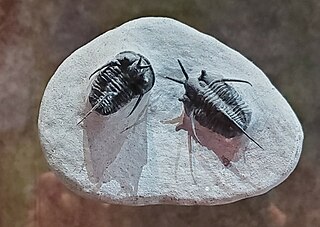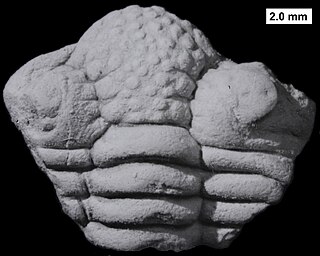Related Research Articles

Robert Adrain was an Irish political exile who won renown as a mathematician in the United States. He left Ireland after leading republican insurgents in the Rebellion of 1798, and settled in New Jersey and Pennsylvania. With Nathaniel Bowditch, he shares the distinction of being the first scholar to publish original mathematical research in America. This included his formulation of the method of least squares while working on a surveying problem for which he is chiefly remembered. His fields of applied mathematical interest included physics, astronomy and geodesy. Many of his mathematical investigations focussed on the shape of the Earth.
The Furongian is the fourth and final epoch and series of the Cambrian. It lasted from 497 to 485.4 million years ago. It succeeds the Miaolingian series of the Cambrian and precedes the Lower Ordovician Tremadocian Stage. It is subdivided into three stages: the Paibian, Jiangshanian and the unnamed 10th stage of the Cambrian.

Hederellids are extinct colonial animals with calcitic tubular branching exoskeletons. They range from the Silurian to the Permian and were most common in the Devonian period. They are more properly known as "hederelloids" because they were originally defined as a suborder by Bassler, who described about 130 species. Although they have traditionally been considered bryozoans, they are clearly not because of their branching patterns, lack of an astogenetic gradient, skeletal microstructure, and wide range in tube diameters. Work continues on assessing the true affinities of hederelloids, but they appear to be most closely related to phoronids and other lophophorates.

Diacalymene is a genus of trilobite from the order Phacopida, suborder Calymenina. It includes the species D. ouzregui, D. clavicula, D. diademata and D. gabrielsi. It lived in the Ordovician and Silurian periods.

The Rural Municipality of Blaine Lake No. 434 is a rural municipality (RM) in the Canadian province of Saskatchewan within Census Division No. 16 and SARM Division No. 5. The RM extends east to the North Saskatchewan River and north to the village of Marcelin.

The Mathematical Diary was an early American mathematical journal and mathematics magazine, published between 1825 and 1833.

Cyphaspis is a genus of small trilobite that lived from the Late Ordovician to the Late Devonian. Fossils have been found in marine strata in what is now Europe, Africa and North America. Various species had a compact body, and a large, bulbous glabellum. Many species had long spines arranged similarly to closely related genera, such as Otarian, Otarionella, Chamaeleoaspis, and Namuropyge.
Aegrotocatellus is a genus of trilobite in the order Phacopida, which existed in what is now Nunavut, Canada. It was named by Adrain and Edgecombe in 1995, and the type species is Aegrotocatellus jaggeri, a species named after British musician Mick Jagger.
Avalanchurus is an extinct genus of trilobites from the Silurian period. It was originally described in 1993 as a subgenus of Struszia, and then promoted in 1997 to genus status.

Frammia is a genus of trilobites in the order Phacopida that existed during the middle and upper Silurian in what is now the Arctic regions of Canada and Russia. It was described by Holtedahl in 1914, and the type species is Frammia dissimilis. That species was subsequently considered to be a synonym of Frammia arctica. The genus also contains the species, F. bachae Adrain & Edgecombe, 1997, F. hyperborea, and F. rossica. The type locality is the Douro Formation of Cornwallis Island in Nunavut, Canadian Arctic.

Gabriceraurus is a trilobite in the order Phacopida, that existed during the upper Ordovician in what is now Canada. It was described by Pribyl and Vanek in 1985, and the type species is Gabriceraurus gabrielsi, which was originally described under the genus Ceraurus by Ludvigsen in 1979. The type locality was the Esbataottine Formation in the Northwest Territories.
Struszia is a genus of fossil trilobites from the Silurian period, erected in 1993 and named after paleontologist Desmond L. Strusz.
Remopleurides is an extinct genus of trilobites.
Ralph Scott McCreath was a Canadian figure skater who competed in single skating, pair skating, ice dancing, and fours. He competed in pairs with Veronica Clarke, Norah McCarthy, Eleanor O'Meara, Bunty Lang, and Betty Chambers, and in fours with fours with Dorothy Caley, Hazel Caley, and Montgomery Wilson, winning the 1939 North American title.
Arcticalymene is a genus of trilobites found in Silurian-aged marine strata of Arctic Canada and Central Victoria, Australia. The Canadian species are named after each of the Sex Pistols: A. cooki, A. jonesi, A. matlocki, A. rotteni and A. viciousi, all named by Adrain and Edgecombe in 1997.

Mackenziurus is a genus of phacopid trilobites from the Silurian containing several species, including four named after members of the American punk band the Ramones.
Hedstroemia is a genus of trilobites in the order Proetida known from the Silurian period of Europe, Asia, and North America.
The Man on the Hill (MOTH) locality of northwestern Canada has fossils that are very well preserved and have had a profound impact on the understanding of vertebrate evolution. The geology of the MOTH locality consists of fine, alternating laminae of light grey argillaceous limestone, or calcareous shale, and dark grey silt to sand-rich calcareous shale, as observed in thin section, and the characterization of the lithology for the vertebrate-bearing strata as an interlaminated argillaceous limestone and calcareous shale. The abundance of cryptic trace fossils and the presence of pyrite suggest that the intra-shelf topographic sag at MOTH had restricted circulation and was generally hypoxic.
Dudleyaspis is an extinct genus of Lower to Middle Devonian odontopleurid trilobites that lived in a shallow sea that lay between Euramerica and Gondwana. It was named in 1949 by Prantl & Pribyl.
References
- 1 2 Jonathan M. Adrain & Mark V. H. Wilson (1994). "Early Devonian cephalaspids (Vertebrata: Osteostraci: Cornuata) from the southern Mackenzie Mountains, N.W.T., Canada" (PDF). Journal of Vertebrate Paleontology . 14 (3): 301–319. Bibcode:1994JVPal..14..301A. doi:10.1080/02724634.1994.10011561. JSTOR 4523572. Archived from the original (PDF) on 2011-08-24.
